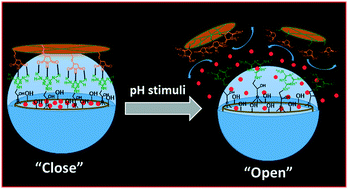当前位置:
X-MOL 学术
›
RSC Med. Chem.
›
论文详情
Our official English website, www.x-mol.net, welcomes your feedback! (Note: you will need to create a separate account there.)
Synthesis of surface capped mesoporous silica nanoparticles for pH-stimuli responsive drug delivery applications
RSC Medicinal Chemistry ( IF 4.1 ) Pub Date : 2017-07-13 00:00:00 , DOI: 10.1039/c7md00270j Madhappan Santha Moorthy 1, 2, 3, 4 , Subramanian Bharathiraja 1, 2, 3, 4 , Panchanathan Manivasagan 1, 2, 3, 4 , Kang Dae Lee 4, 5, 6, 7 , Junghwan Oh 1, 2, 3, 4, 8
RSC Medicinal Chemistry ( IF 4.1 ) Pub Date : 2017-07-13 00:00:00 , DOI: 10.1039/c7md00270j Madhappan Santha Moorthy 1, 2, 3, 4 , Subramanian Bharathiraja 1, 2, 3, 4 , Panchanathan Manivasagan 1, 2, 3, 4 , Kang Dae Lee 4, 5, 6, 7 , Junghwan Oh 1, 2, 3, 4, 8
Affiliation

|
Mesoporous silica-based drug delivery carriers mostly require appropriate surface modifications to improve their drug delivery efficiency and to reduce their adverse side effects. In the present work, we have synthesised mesoporous silica nanoparticles and their surface was covered by using capping units such as tetrathio-maleimide (TTM) via a “host–guest” complexation mechanism for pH-responsive drug delivery applications. The surface-functionalised melamine (Mela) groups on the outer surface of the mesoporous silica nanoparticles act as “hosts” and the surface capped TTM units act as “guests” during the surface capping of the mesoporous silica nanoparticles via the “host–guest” complexation approach. After the encapsulation of cargoes into the mesopore channels, the melamine functional groups were covalently immobilised onto the outer surface of the cargo loaded MSNs and then the TTM units were introduced onto the outer surface of the silica nanoparticles as “gatekeepers” to obtain surface capped mesoporous silica (MSN@Mela@TTM/RhB) NPs to protect the loaded cargo molecules inside the mesopore channels and to prevent their premature leakage. The surface-capped TTM units controlled the drug release behavior with respect to the pH of the release medium. In this study, we used rhodamine B (RhB) as a model cargo to study the loading and pH-responsive release behavior of the MSN@Mela@TTM NPs. The encapsulated RhB molecules were retained inside the mesopore channels at physiological pH (pH 7.4) conditions while an enhanced release occurred at acidic pH (pH 5.0 and 4.0) conditions, respectively. Furthermore, the in vitro biocompatibility and the intracellular uptake efficiency of the synthesised MSNs@Mela@TTM NPs were examined by using the MDA-MB-231 cell line. The experimental results suggest that the MSNs@Mela@TTM nanoparticles are biocompatible and could be utilised for pH-stimuli responsive drug delivery applications.
中文翻译:

用于pH刺激响应性药物递送应用的表面覆盖的介孔二氧化硅纳米粒子的合成
介孔二氧化硅基药物递送载体大多需要适当的表面改性,以提高其药物递送效率并减少其不利的副作用。在目前的工作中,我们已经合成了介孔二氧化硅纳米粒子,并使用封端单元(例如四硫代马来酰亚胺(TTM))通过“宿主-客体”络合机制覆盖了其表面,用于pH响应药物递送应用。在介孔二氧化硅纳米粒子的表面封端过程中,介孔二氧化硅纳米粒子的外表面上的表面官能化三聚氰胺(Mela)基团充当“主体”,而表面封端的TTM单元充当“客体” 。“主客体”复杂化方法。在将货物封装到中孔通道中之后,将三聚氰胺官能团共价固定在载有货物的MSNs的外表面上,然后将TTM单元作为“守门员”引入二氧化硅纳米颗粒的外表面,以获得表面封盖的中孔二氧化硅(MSN @ Mela @ TTM / RhB)NP,以保护中孔通道内装载的货物分子并防止其过早泄漏。相对于释放介质的pH,表面封端的TTM单元控制药物的释放行为。在这项研究中,我们使用罗丹明B(RhB)作为模型货物来研究MSN @ Mela @ TTM NP的负载和pH响应释放行为。封装的RhB分子在生理pH值(pH 7)下保留在中孔通道内。4)在酸性pH(pH 5.0和4.0)条件下分别发生增强释放的条件。此外,使用MDA-MB-231细胞系检查合成的MSNs @ Mela @ TTM NP的体外生物相容性和细胞内吸收效率。实验结果表明,MSNs @ Mela @ TTM纳米颗粒具有生物相容性,可用于pH刺激响应性药物递送应用。
更新日期:2017-09-21
中文翻译:

用于pH刺激响应性药物递送应用的表面覆盖的介孔二氧化硅纳米粒子的合成
介孔二氧化硅基药物递送载体大多需要适当的表面改性,以提高其药物递送效率并减少其不利的副作用。在目前的工作中,我们已经合成了介孔二氧化硅纳米粒子,并使用封端单元(例如四硫代马来酰亚胺(TTM))通过“宿主-客体”络合机制覆盖了其表面,用于pH响应药物递送应用。在介孔二氧化硅纳米粒子的表面封端过程中,介孔二氧化硅纳米粒子的外表面上的表面官能化三聚氰胺(Mela)基团充当“主体”,而表面封端的TTM单元充当“客体” 。“主客体”复杂化方法。在将货物封装到中孔通道中之后,将三聚氰胺官能团共价固定在载有货物的MSNs的外表面上,然后将TTM单元作为“守门员”引入二氧化硅纳米颗粒的外表面,以获得表面封盖的中孔二氧化硅(MSN @ Mela @ TTM / RhB)NP,以保护中孔通道内装载的货物分子并防止其过早泄漏。相对于释放介质的pH,表面封端的TTM单元控制药物的释放行为。在这项研究中,我们使用罗丹明B(RhB)作为模型货物来研究MSN @ Mela @ TTM NP的负载和pH响应释放行为。封装的RhB分子在生理pH值(pH 7)下保留在中孔通道内。4)在酸性pH(pH 5.0和4.0)条件下分别发生增强释放的条件。此外,使用MDA-MB-231细胞系检查合成的MSNs @ Mela @ TTM NP的体外生物相容性和细胞内吸收效率。实验结果表明,MSNs @ Mela @ TTM纳米颗粒具有生物相容性,可用于pH刺激响应性药物递送应用。



























 京公网安备 11010802027423号
京公网安备 11010802027423号